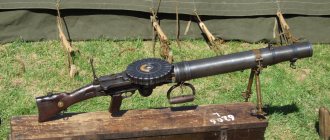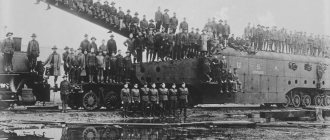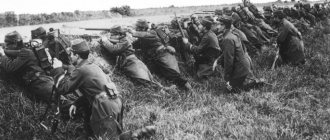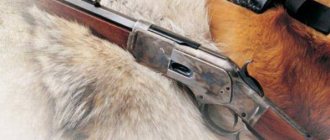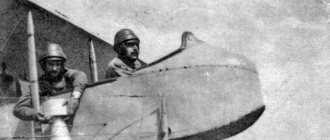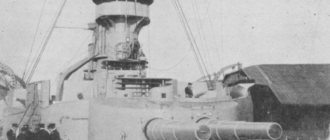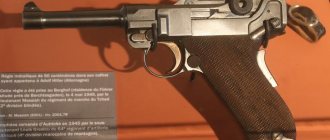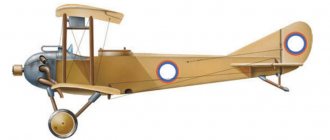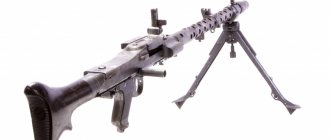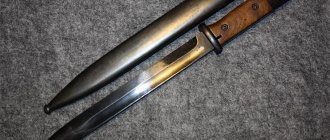The First World War can easily be called the “finest hour” of automatic small arms. Light and heavy machine guns were not only used en masse in the armies of all countries participating in this conflict, but also largely determined its course, leading it to a stalemate, which military historians would later call a “positional deadlock.”
During the First World War or immediately after it, a large number of light and heavy machine guns entered service with various armies: the Hotchkiss, Madsen, Vickers, and Browning machine guns. They had different fates, for example, the Browning machine gun is still in service with the US Army. This material is dedicated to a weapon that experts almost unanimously call the worst machine gun of the First World War, or even the entire twentieth century. We are talking about the French Shosha light machine gun.
The Shosha light machine gun was put into service in 1915, production continued until 1927. During this period, several modifications of the weapon were made that could use different cartridges.
The Shosha machine gun was used not only by the French army, it was used by the armed forces of Greece, Serbia, Poland, the USA and Finland. Despite the low reliability and very mediocre characteristics, the Shosha system machine gun managed to fight. In addition to WWI, it was used during the Russian Civil War, the Soviet-Polish conflict, and the Soviet-Finnish war. These weapons could be found back in the 50-60s in the former French colonies in Africa and Indochina.
Automatic Française
This pistol, the production of which began before 1914, is an imitation of the Mannlicher system. Two long guides extended from the bolt, one on each side, which were connected by a bridge in front under the barrel. The return spring rested against this jumper. The main part of the trunk was open. The pistol with a long stylized handle had an unusual appearance. It is equipped with an automatic safety on the handle, at the base of which there was a magazine release. The manufacturer of this pistol, the French Association of Automatic Arms of Saint-Etienne, ceased operations before the end of the First World War.
The history of the creation of the Shosha machine gun
The First World War did not start very well for the French: in 1914, having launched a powerful offensive, the Germans almost captured Paris. France needed to change something urgently. The first months of trench warfare showed the high effectiveness of machine guns.
Most machine guns of that period had a significant mass, were mounted on a machine and operated by a crew of several people. They were very effective in defense, but were poorly suited for offensive actions. The troops needed a light machine gun that could be carried by one man.
The French created a special commission that was engaged in the development of new weapons. It included: artillery colonel Shosha (French: Chauchat), designer Sutter (in other sources Sutte), as well as Riberol, who was supposed to organize the production of a new machine gun. It is these gentlemen who have the dubious honor of creating a failed machine gun.
The history of the Shosha machine gun began even earlier, before the start of the World War. In 1910, the Hungarian Rudolf Frommer, commissioned by the Swiss army, was developing a light machine gun, the automation of which worked due to the recoil of the barrel with its long stroke. On top of this machine gun there was a magazine with a capacity of twenty rounds. The project turned out to be very unsuccessful, despite all the efforts of the designer, it was never completed and put into service.
For the new machine gun, the French team decided to use Frommer's developments, including the operating principle of the automation. The project was transferred to the commission, and work began to boil. They decided to make the new light machine gun chambered for the 8 mm Lebel cartridge (8×50 mm R) - the world's first cartridge with smokeless powder, developed in 1886. This decision largely determined the low technical and operational characteristics of the future weapon.
The fact is that the 8x50 mm R cartridge had a poorly shaped cartridge case with a noticeably protruding flange, which made the ammunition unsuitable for automatic weapons.
The Shosha machine gun can easily be called a typical wartime weapon. It was created in such a way that production could be established at any non-core enterprise and produce large volumes of products. Initially, the production of machine guns was launched at the bicycle, and the new weapon received the designation CSRG (the first letter of the surnames of everyone involved in the development plus the name of the Gladiator plant). A little later, other factories and workshops joined the production of the machine gun.
A total of 225 thousand Shosh machine guns were manufactured. The US Army acquired more than 37 thousand units of new weapons chambered for the .30-06 Springfield cartridge, 17 thousand of which were transferred to the American Expeditionary Force. This modification (it was called M 1918) had a direct magazine, which was inserted from below into the neck of the receiver. However, the Americans did not like the French machine gun too much: the automatic machine gun could not cope with a more powerful cartridge. So half of the supplied machine guns were returned to warehouses. In the French army, the Shosha machine gun was in service until 1924.
Shosha machine guns were supplied to the Greek armed forces, where they received the loud name “Gladiator”. Another modification (M1915/27) was developed for the Belgian army, chambered for 7.65x53 mm.
The machine gun was also supplied to the Russian army. Back in 1916, the GAU sent a request to the French allies to send 1 thousand machine guns, but the French refused. Later, 100 units of these weapons and 150 thousand pieces of ammunition for them were sent to Russia. Initially they were planned to be used in aviation, but then this idea was abandoned, and the machine guns remained in an artillery warehouse in Kyiv until the end of the war. In 1916, a large order was made for 50 thousand machine guns, which were to be delivered to Russia by mid-1917. However, delivery deadlines were constantly missed: by the beginning of 1917, the French sent only 500 machine guns, then another 5,600 until October 1917.
Shosh machine guns were quite actively used by all participants in the Russian Civil War.
Russian weapons designer and prominent theorist of automatic weapons Vladimir Fedorov had the opportunity to familiarize himself with the first batch of Shosh machine guns. He had a very low opinion of their design. He believed that the automatic design with a long barrel stroke was outdated.
The French machine gun was adopted by the Serbian army; by the end of WWII, the Serbs were supplied with 3,800 units of this weapon. During World War II, the Shosha machine gun was used by various partisan units operating in Yugoslavia.
5 thousand machine guns were supplied to Poland, more than 7 thousand to Romania. The Germans also used captured machine guns, both in the First and Second World Wars.
MAB, model D
in 1933 it began producing a pistol based on the 1910 model Browning. It was a blowback weapon with a return spring attached to the barrel. Single action trigger mechanism. After the occupation of France by Germany in 1939, these pistols were sent in significant quantities to the German army and received the designation “Pistole MAV Kaliber 7.65 mm”. The MAB model D pistol was intended primarily for police use and was considered a durable and accurate weapon suitable for close-range military use.
Anti-tank weapons[edit]
- Anti-tank rifle for boys
- 25 mm Hotchkiss anti-tank gun The main anti-tank gun of France during the Battle of France. Emphasize mobility with small caliber beyond armor penetration
25 mm Hotchkiss anti-tank gun
- 47 mm APX anti-tank gun
- AC 37 anti-tank gun
- AC 47 anti-tank gun
- 47-mm anti-tank gun model 1931
- Canon de 75, model 1897, model 1933
SAKM M1935A
The appearance of the M1935A pistol was preceded by repeated state tests, which began in France back in 1922 and the purpose of which was to find a replacement for the outdated models then in service. Tests in 1933 did not bring satisfactory results. Four candidates took part in the next tests in 1935, and as a result the SAKM pistol won. It was essentially a modified Browning-Colt M1911 pistol. A characteristic feature was a removable assembly, which included the trigger, mainspring, ejector and sear. Manual and magazine safeties were located on the pistol body. One of the factors limiting the distribution of this pistol outside of France was the unique 7.65 mm “long French” cartridge, which was not compatible with foreign weapons.
Armament of the medieval French army
The anonymous manuscript “Du Costume Militairee des Francaise en 1446” tells in great detail about the equipment of the “spear” - the main unit of heavy cavalry. “First of all, it should be said that knights went to war in “white” armor. The armor included a cuirass, bracers, mantles, greaves, gloves, a salet with a visor and a small bevor covering the neck. Each was armed with a spear and a long light sword; a dagger and a mace were hung from the left side of the saddle. Each warrior was accompanied by a squire, equipped with salet, harnois de jamdes, chain mail, jacques, brigandine or corset, armed with a dagger, sword and shortened spear. The retinue included a page or jack, equipped as a squire and armed with one type of weapon. Archers wore greaves, sallets, heavy jackets or brigandines. Their weapons consisted of a bow and a quiver of arrows."
To be fully equipped, a young man needed 125-250 livres. The warrior earned this amount during 8-16 months of service. Even simple armor was quite expensive. A salet cost 3-4 livres, a jacque, corset or brigandine cost about 11 livres. A complete set of armor for a warrior cost about 40 livres, while armor for the entire “spear” cost about 70-80 livres.
The cheapest and lowest-grade dagger cost about one livre. A sword of no quality cost more than one livre. The same text from 1446 states: “Some soldiers wear only chain mail, salute, gloves and greaves. They are usually armed with a kind of broad-headed dart called langue de doeuf (ox tongue).”
Crossbows continued to be produced in large quantities at Clos de Galais. They were usually made in batches of 200 pieces. Ammunition for crossbows was produced in increasing quantities. From three birch logs and 250 kg of iron, about 100,000 crossbow bolts were obtained. Increasing competition from firearms forced craftsmen to improve the design of the crossbow. As a result, the crossbow has become an excellent weapon, combining low weight, no recoil, high penetration ability and ease of operation. The use of steel in the design of the crossbow made it possible to reduce the stroke of the bowstring to 10-15 cm, as well as reduce the span of the shoulders. At the same time, the design of the crossbow became more complicated, and the rate of fire remained low. Cocking a crossbow now required a mechanical device: a lever or a two-handed winch.
Guns were used in increasing numbers. Although the technology for their manufacture has remained virtually unchanged, experimental designs have appeared, for example, disposable weapons with a hard leather barrel. However, the accuracy and reliability of the guns steadily increased, and they could now fire at specific and moving targets, for example, at ships trying to break through to a besieged fortress, or at the masts of enemy ships in a naval battle.
The production of cannons was quite a complex matter, in which many craftsmen of different profiles participated. Only the richest craftsmen could afford to assemble the entire technological chain in their own hands. It was thanks to this circumstance that the Bureau brothers were able to organize the mass production of artillery, which largely contributed to the final victory of France in the last decades of the Hundred Years War. For example, in 1442, Jean Bureau supplied the royal artillery park with six bombards, 16 veuglaires, 20 serpentines, 40 coulevrines and an unknown number of ribaudequins for a total of 4198 livres. These guns required 20,000 pounds of gunpowder, costing 2,200 livres. King Charles VII incurred these considerable expenses, since thanks to the artillery of the Bureau brothers he managed to successfully complete 60 sieges only during 1449-1450.
Infantry, 1360-1415
1. Crossbowman from the retinue of Jean de Angers , 1407.
The large shield bears the coat of arms of Jean de Angers, master of crossbowmen, supplemented by the coat of arms of France. A silver branch is pinned to the warrior's chest. Such badges, indicating a person's political orientation, were common in France at the end of the 14th century. The body is protected by chain mail, brigandine and a quilted thick pupuan. The liner under the bowler helmet is also quite thick. Quilted cuisses partially cover the lamellar leg armor. The back side of the chain mail gloves is reinforced with a metal plate. The crossbowman is armed with a powerful steel crossbow. Note the quiver covered with wolf skin. Hooks for cocking a crossbow are attached to the waist belt. On the left hip hangs a wide stabbing sword (not visible in the picture), and on the right is a basilar dagger.
2. Militiaman from Rennie , 1370
The city foot militia could fight for any of the warring parties. The warrior's equipment does not have any sharp features. Merchants selling armor and weapons could transport their goods over long distances - to where the war was currently going on and there was an increased demand for their goods. The scaly aventail could well have been made in England, the shestoper could have been made in Italy or southern France, the hard leather armor for the legs and arms could have been Flemish, and the chain mail and chausse could have been made in any region of France.
3. Light infantry from the south of France , 1400
The term brigand in those days meant soldiers or mercenaries protected only by a brigandine covered with fabric. This warrior additionally wears a light bascinet over a long-sleeved hood. The neck and shoulders are protected by a chain mail necklace. In addition, the armor includes chain mail and plate gloves. In his hands is a small round shield. The weapon consists of a small sword and a newfangled rondeau dagger.
MAC М1935С
SAKM's capacity turned out to be insufficient to meet the needs of the French army. For this reason, pistols were ordered from one of the less successful applicants - (MAC). The pistol received the designation M1935S. In this version, the barrel and bolt coupling system was different. In appearance, the pistol was distinguished by a straight handle and a slightly protruding front sight. By 1938, the bulk of production came from the M1935S pistol, although SAKM continued production of the M1935A model. A batch of 10,000 M1935S pistols was ordered, production of which began in February 1939. However, before the German invasion, the factory managed to produce only about 1,400 copies. During the occupation of France (1940-1944), these weapons were not produced.
Unique, military model
This is a single action blowback pistol that was produced in Hendaye during the German occupation of France during World War II. The Germans modified its design and, before the liberation of France in 1944, managed to produce over 25,000 pistols under the designation “Kriegsmodel 17”. There was no bolt stop, so the bolt did not remain in the rear position after the last shot. The manual safety was located on the left side of the body and duplicated on the right side, which served to disassemble the weapon. The magazine safety did not allow the gun to fire until the magazine was inserted. The magazine release button was located at the rear of the frame.
The changes made by German designers consisted of adding a trigger and modifying the shape of the handle.
Armored vehicles [edit]
Armored vehicles
- The Panhard 178, which was the main French armored car during the Battle of France, was built as a reconnaissance vehicle.
AM Gendron SOMUA 39
- AMC Schneider P16
- AMD Laffly 80AM
- AMD Panhard 165
- AMDL Panhard
- Laffly S15 TOE (théâtre d'opérations extérieures: "foreign theater of operations") used by French forces in North Africa. Used by Free French forces during the capture of Kufra
Berliet VUDB
- Berliet VUDB4
- Citroen-Kegresse M23
- Laffly S15 NOSE
- Laffley 50am
- Panara 178
Lorraine 38L armored personnel carrier, rear view. Created on the basis of the Lorraine 37L armored tank supply vehicle. The only armored personnel carrier in the battles for France
Armored personnel carriers
Armored personnel carriers
- Lorraine 37L\38L
Armored trucks[edit]
- Renault UE armored supply vehicle. Helped transport weapons and ammunition for the infantry.
Renault UE Chenillette
- Lorraine 37L
Light tanks [edit]
- AMR 33
- AMR 35
- Light infantry tank Renault R-35. The most produced French tank of World War II
FCM 36
- Hotchkiss H35 and derivatives
- Renault FT
- Renault R-35
- Renault R-40
- Char D1
Medium tanks
- Char D2
Cavalry tanks
- SOMUA S-35. One of the best tanks of its time in terms of armor and firepower, superior in this regard to German tanks such as the Panzer III and IV. However, overall they (Panzers) were better tanks as they provided much better visibility, communications and ergonomics than the French tanks, which were generally quite poor in this regard due to things like a one-man turret crew.
SOMUA S35 [1]
- Char G1 (prototype)
Armored combat tanks
- AMC 34
- AMC 35
Heavy tanks
- Char B1
Variant Char B1 bis. The Char B1 was originally conceived as a breakthrough tank, using a hull-mounted cannon to attack fortifications. Eventually became the Char de Bataille or battle tank, designed to fight enemy armored vehicles. Heavily armored and armed for its time, impenetrable to conventional German anti-tank guns. - Char 2C
- ARL 44 (prototype)
- AMX M4 (AMX 50 prototype)
- AMX 50 (Later replace with AMX 30.)
- FCM F1 (prototype)
MAC M1950
In 1950, the French army command announced a competition to create a new pistol, designed to replace all existing models. One of the goals of the competition was the unification of various calibers. After a series of tests, the pistol presented by the Saint-Etienne Arms Factory (MAC) was accepted into service. This pistol with a short barrel stroke was an improved version of the M1935C model. The manual and magazine fuses were the same as those on the M1935S. When the safety was on, the hammer was released from the cocking position. Although the pistol was developed by the Arms Factory in Saint-Etienne, the bulk of the production was initially produced by the Arms Factory in Chatellerault. However, in 1961 production was moved to Saint-Etienne.
MAB PA-15
This pistol, chambered in 9 mm Parabellum, was a more or less successful attempt by France to break into the arms market. A single-action pistol with a bulky grip that accommodated a wider magazine. There was a pronounced spur at the rear of the body. The semi-slow action blowback is unusual for pistols of this type. The trigger mechanism is trigger. The barrel is rotatable, but motionless. A fuse located on the bolt prevented an accidental shot when the magazine was removed. MAB PA-15 was introduced in 1952 and was purchased in small quantities by the French army and Finnish border troops. Its production ceased in the late 1980s.
Since the PA-15 pistol was single action, it could not compete with the Czech 43-75.
Artillery[edit]
- Canon d'Infanterie de 37, model 1916 TRP
- 95 mm Lahitolle gun
- Canon Court de 105 M (mountain), model 1909, Schneider
- Canon de 105 model 1913 Schneider. Most widely available light artillery for the French Army in the Battle of France
Canon Court de 105 M (mountain), model 1919, Schneider
- Canon de 105 court mle 1934 Schneider
- Canon de 105 court mle 1935 B
- Canon de 105 L mle 1936 Schneider
- Canon de 105 mle 1913 Schneider
- Canon de 155 C, model 1917, Schneider. Most common large caliber artillery for France during the Battle of France
Canon de 155 C, model 1915, Saint-Chamond
- Canon de 155 C, model 1917, Schneider
- Canon 155mm GPF
- Canon de 194 mle GPF
- Canon de 65 M (mountain), model 1906
- Canon de 75 M (mountain), model 1919, Schneider
- Canon de 75 M (mountain), model 1928
- Canon de 75, model 1897
- Mortier de 280 modèle 1914 Schneider
Manurin MP73
A double-action revolver with interchangeable drums chambered for two types of cartridges, with the spare drum chambered for the Parabellum cartridge. Developed in 1973, it was available in a variety of barrel lengths to suit the needs of military, police and competitive shooters. This revolver quickly earned an excellent reputation as both a service and sporting weapon. He received equally high praise in sports circles and in elite military and police units. The MP73's trigger is considered one of the smoothest and easiest, and the design of the revolver deserves the highest praise. For example, a cold forged barrel is distinguished by both durability and high accuracy.
This revolver was intended not only for the French police, but also for elite units performing special assignments.
MAC ZHI
This pistol is not much different from the Beretta M92 with a short barrel stroke. It was produced in the 1970s. The trigger mechanism is double-action, the automatic mechanism uses recoil energy during a short stroke of the barrel, locking occurs with a cylinder swinging in a vertical plane. Unlike the Italian Beretta M92, the lever on the bolt has only the function of safely releasing the trigger, and the trigger mechanism is not blocked. The magazine release is located at the bottom of the handle. The pistol caused criticism due to the quality of the steel used to produce the bolt, which was hard and at the same time brittle due to the high tellurium content in it, which sometimes caused the destruction of the bolt.
Share link
